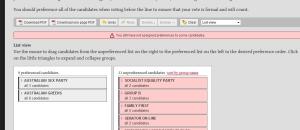
I tried Twitter last year, when the hype was still gaining speed before its dizzying take off. I didn’t stay for long – my friends were reluctant to try it and while it was exciting for a few days to find out what celebrities ate for lunch, I quickly got bored and returned to the comfy confines of Facebook.
But now I’m back, ready to embrace the 24-hour connectivity, to share my innermost thoughts with complete strangers and to sit staring at the update bar for an hour thinking of how to be witty and wondering if anyone is really interested in what the cat dug up in the garden.
I’m still not hooked up to Twitter constantly, which is not ideal for the dedicated Twitter user. If you’re following a large number of people you can miss a lot by logging in and out every so often. I’m also still uncertain about the “right” people to follow and the “right” things to tweet.
* * *
It’s disturbingly easy to find actors, writers, comedians and sportspeople ready to share their personal lives in often excruciatingly minute detail. I find Twitter works best when it is used as a marketing tool. An actor can tell fans about what film they’re currently starring in, a writer can share their writing process with readers or a television personality can advertise their program.
 I found this view by an AFL footballer on the use of Twitter quite interesting. Cale Morton from the Melbourne Demons encourages fans to follow the Demons players who are using Twitter, and I was a bit surprised by his view on the interaction between players and the public. He says he follows journalists to receive breaking news and sees Twitter as a beneficial tool in connecting the club to its supporters. He reveals the football club’s attitude towards social media:
I found this view by an AFL footballer on the use of Twitter quite interesting. Cale Morton from the Melbourne Demons encourages fans to follow the Demons players who are using Twitter, and I was a bit surprised by his view on the interaction between players and the public. He says he follows journalists to receive breaking news and sees Twitter as a beneficial tool in connecting the club to its supporters. He reveals the football club’s attitude towards social media:
“Before you feel like you’re intruding a bit on our personal lives, Twitter is predominately a public forum – everything is for all eyes to see. At the Demons, we are encouraged to provide this insight for fans and followers to enjoy – led by fellow Twitterers Jim Stynes and Cameron Schwab!”
Twitter is a powerful way to communicate if used in the right way. Being free and easy, it breaks down the barriers between content producers and celebrities and the ordinary fan.
* * *
Just as there is good and bad web writing, there is good and bad tweeting. The best tweets are funny or informative, or link to something that is funny or informative, the worst ones are dull and rarely updated.
 For an example, a quick visit to TonyAbbott’s twitter page shows his last tweet:
For an example, a quick visit to TonyAbbott’s twitter page shows his last tweet:
“This election is about giving a great people a better government. The Coalition will end the waste, stop the taxes and stop the boats.” – 6:35 PM Jul 17th via web
This, in my opinion is a BAD tweet. It shows little regard for the platform on which it is posted. A slogan posted almost a month ago does not an active Twitter user make. Compare this to Julia Gillard. In the middle of my writing this blog post, Julia Gillard has tweeted to her followers:
“Switched on the NBN in Tasmania today. It will deliver faster internet to Australians & create jobs but @TonyAbbottMHR wants to axe it. 5 minutes ago via Twitter for iPhone”
No, it’s not a brilliant tweet, but it uses some Twitter infrastructure and it was done from an iPhone! How hip and trendy! The language is also more appropriate for a more informal platform.
Being new to Twitter I’m still trying to discover what constitutes ‘good’ tweeting. When presenting links to a photo, video or web article it seems important to provide some comment or explanation of it. Good spelling and grammar is still important, which is surprising for such a quick medium. I would have thought abbreviations would have become commonplace, but most Twitter users put lots of information across multiple tweets rather then trying to cram it all in one.
Over the next few weeks I expect I’ll pick up some of the conventions of Twitter. In the meantime you can follow me at @lizchomiak and witness all my Twittering mistakes.
Tags: Australian Politics, Twitter













